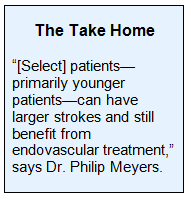Key Points:
- Good outcomes possible with endovascular therapy for stroke patients with large lesions
- Younger patients have best outcomes
Although the risks of poor function and symptomatic intracerebral hemorrhage are increased in stroke patients with large lesions who undergo endovascular therapy, one-third still derive a favorable outcome after successful reperfusion. Yet the risk/benefit ratio becomes less positive when looking at those who have poor or failed reperfusion, according to registry data published online August 24, 2015, ahead of print in Stroke.
Therefore, patient selection is key in this subgroup, advise Gerhard Schroth, MD, of University Hospital Bern (Bern, Switzerland) and colleagues.

For the trial, the investigators examined outcomes among 372 patients with middle cerebral (n = 266) or internal carotid artery (n = 106) occlusions who were examined using MRI before treatment since 2004. Diffusion-weighted imaging (DWI) lesion volumes were measured semiautomatically, and baseline and 3-month outcome data were recorded prospectively.
Overall, favorable outcome (defined as a modified Rankin Scale (mRS) score of 0-2) was attained in 159 of 292 (54.5%) patients with lesions < 70 mL on DWI and in 14 of 66 (21.2%) patients with lesions > 70 mL (P < .001).
Multivariate regression analysis revealed that increasing lesion volume as measured by DWI was a significant and independent negative predictor of favorable outcome and survival and a positive independent predictor of symptomatic intracerebral hemorrhage (P < .001).
Successful reperfusion was closely tied to outcome. In the large-lesion group, 35.5% of patients with TICI 2b-3 reperfusion who achieved TICI 2b-3 reperfusion attained a favorable outcome by 3 months, compared with only 8.6% of those with TICI 0-2a reperfusion (P = .014). Overall, 19.7% of patients with lesions > 70 mL experienced symptomatic intracerebral hemorrhage, with a trend for reduced risk with avoidance of thrombolytic agents. In comparison, patients with smaller lesions had a symptomatic intracerebral hemorrhage rate of 3% (P < .001).
In the large-lesion group, independent predictors of 3-month outcome were reperfusion success, patient age, and lesion volume (table 1).
Table 1. Predictors of mRS Score 0-2 at 3 Months in Patients With DWI Lesions > 70 mL
|
|
OR (95% CI) |
P Value |
|
Reperfusion TICI 2b-3 |
6.613 (1.159-37.735) |
.034 |
|
Patient Age |
0.902 (0.848-0.960) |
.001 |
|
DWI Lesion Volume |
0.498 (0.270-0.921) |
<.001 |
“Our data indicate that patients with large DWI lesion volumes should not be strictly excluded from endovascular treatment, as favorable outcome was achieved in every third patient with DWI lesion volumes > 70 mL after successful endovascular reperfusion,” the authors write. “Especially younger patients with large initial DWI lesions may benefit from endovascular treatment, and the avoidance of thrombolytic agents might reduce the risk of [symptomatic intracerebral hemorrhage]. Nevertheless, further studies are needed to validate the treatment effect and to optimize patient selection.”
A Shift in the Literature
In a telephone interview, Philip M. Meyers, MD, of NewYork-Presbyterian Hospital/Columbia University Medical Center (New York, NY), told TCTMD that identification of which stroke patients are suitable for endovascular therapy “remains an issue.”
In 2013, no fewer than 3 trials—MR RESCUE, IMS III, and SYNTHESIS Expanded—“failed to identify a statistically significant benefit to endovascular stroke intervention, in part because patient selection criteria were too broad,” he pointed out. “Using more stringent selection criteria, a new set of trials published in 2014-2015 [ESCAPE, EXTEND-IA, and SWIFT PRIME] now demonstrate the benefit of stroke intervention in a more highly selected group of patients. However, there may be additional patients the new trials overlooked who would still benefit from emergency revascularization procedures.”
“This study shows that endovascular reperfusion may still benefit patients despite large strokes at the time of initial assessment,” continued Dr. Meyers. While previous trials have suggested that patients with acute strokes larger than 50 to 70 mL may not benefit from an endovascular approach, these data suggest “[select] patients—primarily younger patients—can have larger strokes and still benefit from endovascular treatment.”
Improving Patient Selection
Research is ongoing as to how to best identify candidates for emergency endovascular stroke treatment, said Dr. Meyers, who emphasized that advanced imaging will play a crucial role.
“Physical examination alone does not determine which acute stroke victims will benefit most from intervention,” he said, noting that recent trial data support selection via imaging. “Now, we need to figure out how much imaging and which types of imaging are required to effectively identify the greatest number of patients eligible for treatment. These imaging tests will probably include techniques that allow us to assess how much brain is irrevocably damaged, how much brain remains at risk, and what is the status of collateral blood vessels that are keeping the brain alive.”
The next step in uncovering eligible patients, continued Dr. Meyers, is to conduct randomized trials that include the types of patients identified by registries. Multicenter stroke trials exploring similar issues include DAWN, POSITIVE, and DIFFUSE 3, he reported.
Source:
Gilgen MD, Klimek D, Liesirova KT, et al. Younger stroke patients with large pretreatment diffusion-weighted imaging lesions may benefit from endovascular treatment. Stroke. 2015;46:2510-2516;Epub ahead of print.
Disclosures:
- Drs. Shroth and Meyers report no relevant conflicts of interest.

